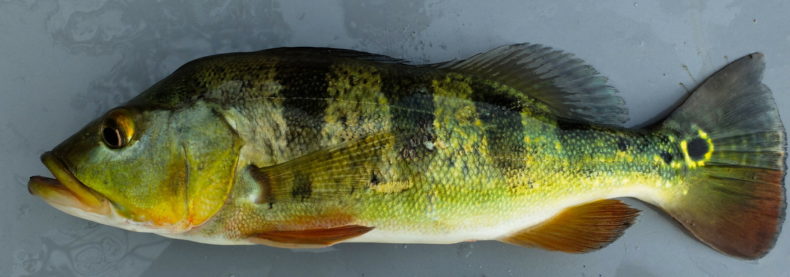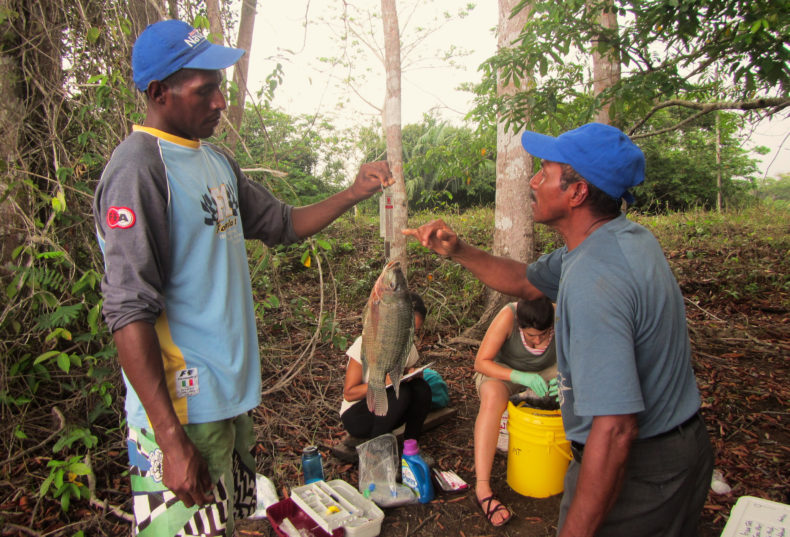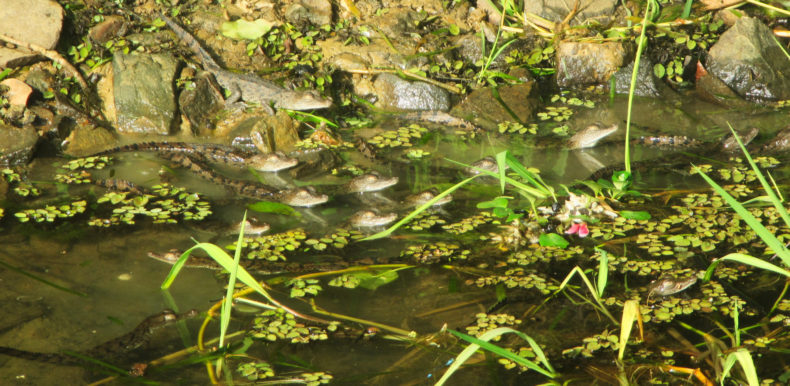The crocodiles should not be a problem. Yes, the population has spiked after being placed under protection, and there have been some attacks recently. But those attacks tend to happen when somebody steps right into the water. The crocs all hang out in the shallows. Stay out of the water and you should be fine. So said the team of forest rangers at the Smithsonian Tropical Research Institute.
Diana Sharpe looked down at her mesh beach seine—the big, soft net she would use to drag across the water just off the beach and catch the little shallow-water fish for sampling. She looked over at her little tin boat with its outboard engine.
“We just tried to basically be very vigilant. We saw lots of crocodiles, but if we came to a spot where we were planning to sample and we saw footprints or evidence of crocodiles we would leave and try another spot,” says Sharpe.
Gatun Lake, which comprises 33 of the 77 kilometres of the Panama Canal, has a peacock bass problem. The locals don’t see it as a problem—even if they happen to know it’s not native they defend its value as a great sport fish—but it’s the kind of apex predator the Panama Canal region had never seen. That is, until 1967, when a business man’s pond, stocked with a hundred of the South American fish for his employees’ enjoyment on weekends, overflowed during a heavy rain. Little juvenile peacock bass escaped into the Chagres River and from there into Lake Gatun.
 Most introduced species don’t establish at all. They find themselves in an environment they’re not suited to, without a niche to call their own. But top predators are notoriously potent as invasive species. Just as the Nile perch led to many extinctions in Lake Victoria and cats wreak havoc on oceanic islands, the peacock bass came to town and found its would-be competitors were smaller-bodied, sit-and-wait predators, lurking on the bottom of the lake in camouflage. Most of them were also nocturnal, while the newcomer was a diurnal active pursuit predator. As a voracious hunter—a “freshwater bully” known to damage fishing gear—the peacock bass had easy access to all the prey species that never co-evolved with something that would chase them.
Most introduced species don’t establish at all. They find themselves in an environment they’re not suited to, without a niche to call their own. But top predators are notoriously potent as invasive species. Just as the Nile perch led to many extinctions in Lake Victoria and cats wreak havoc on oceanic islands, the peacock bass came to town and found its would-be competitors were smaller-bodied, sit-and-wait predators, lurking on the bottom of the lake in camouflage. Most of them were also nocturnal, while the newcomer was a diurnal active pursuit predator. As a voracious hunter—a “freshwater bully” known to damage fishing gear—the peacock bass had easy access to all the prey species that never co-evolved with something that would chase them.
In less than 10 years, the peacock bass became the lake’s dominant species, and seven of the 11 previously most common fish species had been eliminated. The impacts were felt up and down the food chain, dramatically affecting anything that depended on those small prey fish that were being gobbled up. Tarpon, black terns, kingfishers and herons all suffered, and on the other end, there was a resurgence of malaria vector mosquitos that had been kept in check by the small fish.
Fifty years ago, ecologists Bob Paine and Tom Zerat took a study of the effects of this invasion on the ecology of Gatun Lake. In a classic 1973 article in Science, they speculated about the future: “We anticipate an eventual return to some form of equilibrium. However, it will be some time before we can evaluate the permanence or transience of the many changes.”
It was, indeed, some time, but young ecologists two generations later took up the challenge. Replicating the exact methods that Paine and Zerat had employed – beach seining for littoral fish—Sharpe decided to find out whether the equilibrium hypothesis was correct. This was harder than it sounds.
“Tom Zerat passed away as a young man, but I was able to get in touch with Bob Paine, who is a very famous ecologist who passed away this year in his 80s,” says Sharpe. “He told us what he remembered, but it was of course a long time ago. And in those days they didn’t have GPS, so he couldn’t tell me where they had gone exactly. This is where the crocodiles come in.”
The crocodiles are a new problem, as when the original study was conducted, the Panama Canal was under American control and crocodiles were hunted.
 Sharpe’s study found that the effect of the introduction was very much permanent. The prey species collapse was sustained, at 96% lower than the pre-invasion levels. There was no recovery of the original ecosystem, nor is there likely to be in the future. And the reason this matters is that we’re about to see it happening a lot more often, even there in the Panama Canal.
Sharpe’s study found that the effect of the introduction was very much permanent. The prey species collapse was sustained, at 96% lower than the pre-invasion levels. There was no recovery of the original ecosystem, nor is there likely to be in the future. And the reason this matters is that we’re about to see it happening a lot more often, even there in the Panama Canal.
Sharpe’s sampling showed that there are many, many marine species in Gatun Lake, which was created in 1914 by damming the Chagres River into a 164 square-mile reservoir instead of dredging the whole Panama Canal as a deep channel. Coastal species that can tolerate freshwater swim in while the locks are open and, in so doing, eventually transfer themselves from the Atlantic to the Pacific Ocean or vice versa.
A lot of invertebrates have made the crossing already, some in the ballast water of ships. In June 26, 2016, the Panama Canal finished a large expansion project that widened the channel, and there is now a third set of locks and a new lane of traffic. Historically separate Caribbean and Pacific fish faunas have mixed. Elsewhere, ports and major shipping lanes have always been hubs of invasive species, and now that movement is interacting with climate change and the opening of ice-free Arctic waters.
“It’s going to be just a really interesting soup,” says Sharpe, who prefers to see natural experiments like this as fascinating rather than alarming. It’s probably a mentally healthy approach for any 21st century ecologist.
Images: Diana Sharpe
